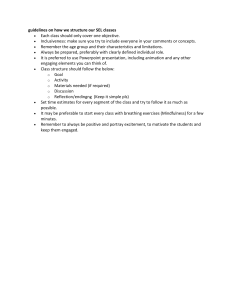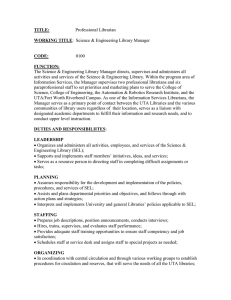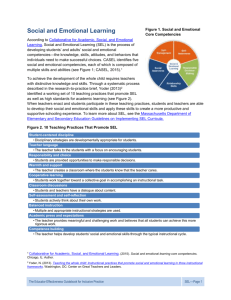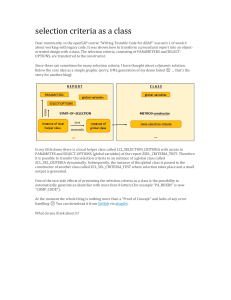Output-for-Policy-Analysis-and-Development-Surname-First-Name
advertisement
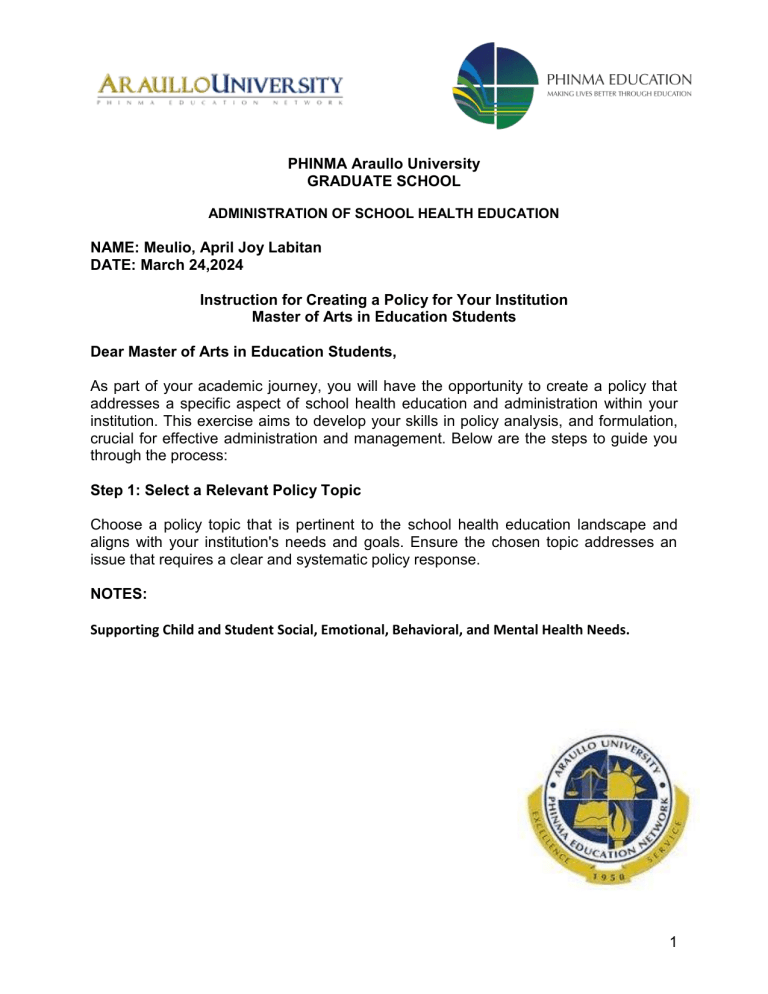
PHINMA Araullo University GRADUATE SCHOOL ADMINISTRATION OF SCHOOL HEALTH EDUCATION NAME: Meulio, April Joy Labitan DATE: March 24,2024 Instruction for Creating a Policy for Your Institution Master of Arts in Education Students Dear Master of Arts in Education Students, As part of your academic journey, you will have the opportunity to create a policy that addresses a specific aspect of school health education and administration within your institution. This exercise aims to develop your skills in policy analysis, and formulation, crucial for effective administration and management. Below are the steps to guide you through the process: Step 1: Select a Relevant Policy Topic Choose a policy topic that is pertinent to the school health education landscape and aligns with your institution's needs and goals. Ensure the chosen topic addresses an issue that requires a clear and systematic policy response. NOTES: Supporting Child and Student Social, Emotional, Behavioral, and Mental Health Needs. 1 Step 2: Conduct Research Thoroughly research the chosen topic to gather relevant data, statistics, best practices, and existing policies. This step will help you understand the problem, its underlying causes, and potential solutions. NOTES: Challenges: 1. Rising Mental Health Needs and Disparities Among Children and Student Groups 2. Perceived Stigma is a Barrier to Access 3. Ineffective Implementation of Practices 4. Fragmented Delivery Systems 5. Policy and Funding Gaps 6. Gaps in Professional Development and Support 7. Lack of Access to Usable Data to Guide Implementation Decisions. Recommendations: 1. Prioritize Wellness for Each and Every Child, Student, Educator, and Provider 2. Enhance Mental Health Literacy and Reduce Stigma and Other Barriers to Access 3. Implement Continuum of Evidence-Based Prevention Practices 4. Establish an Integrated Framework of Educational, Social, Emotional, and Behavioral-Health Support for All 5. Leverage Policy and Funding 6. Enhance Workforce Capacity 7. Use Data for Decision Making to Promote Equitable Implementation and Outcomes 2 Step 3: Identify Stakeholders Identify the key stakeholders who will be affected by the policy. These stakeholders could include patients/students, healthcare providers, administrators, regulatory bodies, and other relevant parties. NOTES: A child's well-being encompasses their social, emotional, behavioral, and mental health. Supporting these needs requires a collaborative effort from various stakeholders. Within the School System: Educators (Teachers, Counselors, School Psychologists): They are on the front liners, who will interact with students daily and often the first to identify potential challenges. Administrators (Principals, Assistant Principals): They provide leadership, set the school climate, and allocate resources for mental health programs. School Nurses: They address immediate physical health concerns that can sometimes be linked to emotional or behavioral issues. Family and Caregivers: Parents and Guardians: They have the most significant influence on a child's life and play a crucial role in promoting positive mental health at home. Extended Family Members: They can offer support and stability, especially for children in complex family situations. Community and Broader Systems: Mental Health Professionals: They provide diagnosis, treatment, and support for students with specific mental health needs. Community-Based Organizations: They offer after-school programs, mentoring services, and other resources that can address social and emotional needs. Policymakers (Government Agencies): They influence funding for mental health programs and create policies that support student well-being. Additional Stakeholders: Faith-Based Organizations: They can provide spiritual support and a sense of belonging for students. Law Enforcement and Juvenile Justice System: They play a role in intervening with students experiencing crisis or exhibiting concerning behaviors. 3 Step 4: Define Policy Objectives Clearly define the objectives of your policy. What specific outcomes do you aim to achieve? Your objectives should be measurable, realistic, and aligned with the overall goals of your institution. NOTES: To prioritize student and staff wellness: This creates a supportive school environment that fosters positive mental health for everyone. To enhance mental health literacy: Educate students, staff, and families about mental health, reducing stigma and encouraging help-seeking behavior. To implement social-emotional learning (SEL) programs: These programs provide students with skills to manage emotions, build relationships, and make responsible decisions. To create a positive school climate: This involves fostering a sense of belonging, safety, and respect for all students. Step 5: Formulate Policy Strategies Based on your research, develop a set of strategies that will address the identified problem and achieve your policy objectives. These strategies should be wellresearched, evidence-based, and feasible within the resources available. NOTES: Prioritize Wellness for All: This means fostering a culture that prioritizes mental health alongside academic achievement for students, educators, and staff. Create a Safe Space: Schools should be a place where students feel secure and respected, regardless of background or challenges. Integrate SEL into Academics: Weaving social-emotional learning into everyday lessons practically reinforces these skills. Tiered Support System: A layered approach provides universal prevention strategies for all students, targeted supports for those at-risk and intensive interventions for students with greater needs. Mental Health Professionals: Schools should have access to counselors, psychologists, or social workers to provide support and connect students with further resources. 4 Family and Community Collaboration: Partnering with parents and caregivers is crucial for consistent support. Professional Development: Equipping educators with skills to identify and address mental health concerns is essential. Data-Driven Decisions: Tracking progress and outcomes helps measure the effectiveness of implemented strategies. Step 6: Draft the Policy Write a comprehensive policy document that outlines the purpose, objectives, strategies, implementation plan, responsible parties, and evaluation methods. Ensure that the language is clear, concise, and easy to understand. NOTES: I. Purpose This policy establishes a comprehensive framework to support the social, emotional, behavioral, and mental health (SEBMH) needs of all children and students. We recognize that a student's well-being directly impacts their academic success and overall development. This policy aims to create a safe and supportive learning environment where students can thrive. II. Objectives Promote positive mental health and emotional well-being for all students. Identify and address SEBMH concerns early and effectively. Provide a continuum of support services to meet the diverse needs of students. Foster collaboration among school staff, families, and community partners to ensure comprehensive support. Increase student academic achievement and social-emotional learning (SEL) competencies. III. Strategies A. Universal Prevention: Integrate SEL curriculum into all grade levels, fostering self-awareness, social awareness, relationship skills, responsible decision-making, and self-management. Create a positive school climate that promotes respect, inclusion, and belonging. 5 Implement trauma-informed practices throughout the school environment. Train staff in recognizing and responding to early signs of SEBMH concerns. B. Targeted Intervention: Develop a multi-tiered system of support (MTSS) to identify and address students at risk for SEBMH challenges. Provide targeted SEL interventions for students with specific needs, such as social skills groups or anger management training. Offer individual counseling services within the school or through partnerships with external providers. C. Intensive Support: Develop individualized support plans for students with diagnosed mental health conditions. Collaborate with families and external mental health professionals to ensure coordinated care. Provide appropriate accommodations and modifications within the classroom setting. IV. Implementation Plan Professional Development: All staff will receive on-going professional development on SEBMH best practices, including recognizing warning signs, implementing SEL strategies, and providing appropriate referrals. Data Collection and Analysis: Regularly monitor student data (attendance, behavior, grades, surveys) to identify trends and areas for improvement. Community Collaboration: Build partnerships with local mental health professionals, family support services, and community organizations to offer comprehensive resources to students and families. Communication and Outreach: Provide clear communication channels for students, families, and staff regarding available SEBMH supports. V. Responsible Parties School Leadership: Develop and implement the SEBMH policy, including allocating resources and overseeing program success. Teachers and Staff: Implement SEL curriculum, intervene in situations of concern, and refer students for additional support. School Counselors and Social Workers: Provide individual and group counseling, collaborate with families and external providers, and manage student support plans. Parents and Families: Actively participate in their child's SEBMH well-being, communicate concerns, and collaborate with school staff. 6 VI. Evaluation Methods Student Surveys: Conduct regular surveys to assess student perceptions of school climate, SEBMH supports, and overall well-being. Data Analysis: Analyze student data (attendance, discipline referrals, grades) to measure the impact of SEBMH programs. Stakeholder Feedback: Gather feedback from staff, families, and community partners regarding the effectiveness of the policy and its implementation. Program Review: Conduct regular reviews of the SEBMH policy to ensure effectiveness and alignment with best practices. This policy will be reviewed and updated periodically to reflect evolving needs and best practices. VII. Conclusion By actively promoting and supporting the SEBMH needs of all students and fosters a learning environment that empowers students to succeed academically, socially, and emotionally. Step 7: Consultation and Review Share your policy draft with relevant stakeholders (or colleagues) for feedback. Incorporate their insights to enhance the policy's comprehensiveness and effectiveness. NOTES: Add additional information for the timeline of the policy. 7 Step 8: Implementation Plan Create a detailed plan for implementing the policy. Specify timelines, responsible parties, required resources, and communication strategies. NOTES: Timeline: Phase 1: Planning & Development (Months 1-3) Phase 2: Implementation & Pilot (Months 4-12) Phase 3: Expansion & Sustainability (Months 13+) Responsible Parties: School Leadership Team: Principal, Assistant Principal(s) SEBMH Committee: Educators, School Counselor, Social Worker, Parents, Community Mental Health Representative Educators: All teaching staff Parents/Guardians: School community Required Resources: Funding: Explore grants, partnerships with mental health organizations, and budget reallocations to support SEBMH initiatives. Personnel: Hire or train additional counselors, social workers, and mental health professionals. Provide professional development for educators on SEBMH best practices. Curriculum & Materials: Implement social-emotional learning (SEL) curriculum at all grade levels. Develop resources for parents and educators on SEBMH topics. Technology: Utilize online platforms for mental health screenings, self-help resources, and communication with families. Space: Dedicate a space within the school for individual counseling sessions and small group support activities. Communication Strategies: Phase 1: School Leadership Team: Convene meetings to discuss the plan, identify champions, and assign responsibilities. SEBMH Committee: Develop a communication plan for stakeholders, including parents, educators, and community partners. 8 School Community: Conduct surveys and town hall meetings to assess needs and gather feedback. Introduce the SEBMH initiative through school announcements, newsletters, and the school website. Phase 2: Educators: Provide training workshops on SEBMH identification, intervention strategies, and classroom management techniques. Parents/Guardians: Organize workshops on supporting children's SEBMH needs at home. Offer parent-teacher conferences focused on individual student well-being. Community: Partner with mental health organizations to offer school-based services and connect families with resources. Phase 3: School Community: Regularly share data on program effectiveness and student outcomes. Host annual events promoting mental health awareness. Sustainability: Advocate for on-going funding and policy changes to support SEBMH initiatives at local, municipal, and provincial levels. Step 9: Evaluation Mechanism Develop a framework to evaluate the policy's impact. Identify key performance indicators that will help assess the effectiveness of the policy and determine if the desired outcomes are being achieved. NOTES: Key Performance Indicators (KPIs): Student-Level Outcomes: Social-Emotional Learning (SEL) Skills: Measure growth in skills like selfawareness, relationship management, responsible decision-making using standardized assessments or teacher observations. Mental Health Status: Track rates of depression, anxiety, or other mental health concerns through surveys or screening tools. Academic Performance: Monitor changes in grades, attendance rates, or standardized test scores. Disciplinary Actions: Analyze trends in disciplinary referrals or suspensions. School-Level Outcomes: School Climate Surveys: Conduct surveys of students, staff, and parents to assess perceptions of safety, support, and inclusivity. Absenteeism Rates: Monitor school-wide absenteeism trends. 9 Community-Level Outcomes: Utilization of Mental Health Services: Track utilization rates of school-based or community mental health services. Collaboration with Community Partners: Evaluate the effectiveness of partnerships between schools and community organizations to address SEBMH needs. Step 10: Presentation and Approval Present your policy to your peers and faculty members. Seek their feedback before finalizing the policy. NOTES: Step 11: Finalize the Policy Incorporate all feedback and finalize the policy document. Ensure that it is wellstructured, and coherent. FINAL POLICY I. Purpose This policy establishes a comprehensive framework to support the social, emotional, behavioral, and mental health (SEBMH) needs of all children and students. We recognize that a student's well-being directly impacts their academic success and overall development. This policy aims to create a safe and supportive learning environment where students can thrive. 10 II. Objectives Promote positive mental health and emotional well-being for all students. Identify and address SEBMH concerns early and effectively. Provide a continuum of support services to meet the diverse needs of students. Foster collaboration among school staff, families, and community partners to ensure comprehensive support. Increase student academic achievement and social-emotional learning (SEL) competencies. III. Strategies A. Universal Prevention: Integrate SEL curriculum into all grade levels, fostering self-awareness, social awareness, relationship skills, responsible decision-making, and self-management. Create a positive school climate that promotes respect, inclusion, and belonging. Implement trauma-informed practices throughout the school environment. Train staff in recognizing and responding to early signs of SEBMH concerns. B. Targeted Intervention: Develop a multi-tiered system of support (MTSS) to identify and address students at risk for SEBMH challenges. Provide targeted SEL interventions for students with specific needs, such as social skills groups or anger management training. Offer individual counseling services within the school or through partnerships with external providers. C. Intensive Support: Develop individualized support plans for students with diagnosed mental health conditions. Collaborate with families and external mental health professionals to ensure coordinated care. Provide appropriate accommodations and modifications within the classroom setting. IV. Implementation Plan Professional Development: All staff will receive on-going professional development on SEBMH best practices, including recognizing warning signs, implementing SEL strategies, and providing appropriate referrals. Data Collection and Analysis: Regularly monitor student data (attendance, behavior, grades, and surveys) to identify trends and areas for improvement. 11 Community Collaboration: Build partnerships with local mental health professionals, family support services, and community organizations to offer comprehensive resources to students and families. Communication and Outreach: Provide clear communication channels for students, families, and staff regarding available SEBMH supports. Timeline Phase 1: Conduct needs assessment, develop SEBMH action plan, and begin staff training on SEL and mental health literacy. Phase 2: Implement Tier 1 universal prevention strategies and pilot Tier 2 targeted interventions. Phase 3: Fully integrate Tier 2 interventions, begin development of Tier 3 supports, and establish partnerships with community mental health providers. Ongoing: Continuously monitor progress, evaluate effectiveness, and make adjustments to the plan as needed. V. Responsible Parties School Leadership: Develop and implement the SEBMH policy, including allocating resources and overseeing program success. Teachers and Staff: Implement SEL curriculum, intervene in situations of concern, and refer students for additional support. School Counselors and Social Workers: Provide individual and group counseling, collaborate with families and external providers, and manage student support plans. Parents and Families: Actively participate in their child's SEBMH well-being, communicate concerns, and collaborate with school staff. VI. Evaluation Methods Student Surveys: Conduct regular surveys to assess student perceptions of school climate, SEBMH supports, and overall well-being. Data Analysis: Analyze student data (attendance, discipline referrals, grades) to measure the impact of SEBMH programs. Stakeholder Feedback: Gather feedback from staff, families, and community partners regarding the effectiveness of the policy and its implementation. Program Review: Conduct regular reviews of the SEBMH policy to ensure effectiveness and alignment with best practices. 12 This policy will be reviewed and updated periodically to reflect evolving needs and best practices. VII. Conclusion By actively promoting and supporting the SEBMH needs of all students and fosters a learning environment that empowers students to succeed academically, socially, and emotionally. Step 12: Dissemination and Implementation (NO NEED TO CONDUCT) Work with relevant departments to disseminate the policy to all relevant stakeholders. Ensure that everyone understands their roles and responsibilities in implementing the policy. Remember that policy creation is an iterative process. Be open to refining and adapting your policy as new information emerges or circumstances change. Your efforts will contribute to effective healthcare administration and further develop your skills in policy analysis and formulation. 13

